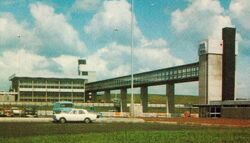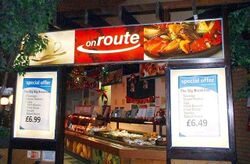History of Heart of Scotland (Harthill) services
< return to Heart of Scotland (Harthill) services

Photos of the service area in the 1970s.

Originally named Harthill services, this was the first service area in Scotland when it fully opened in 1971.
The Scottish Office approached England's Ministry of Transport in 1963, asking them for advice on motorway service areas. The Ministry of Transport explained that their experience with roads like the M1 and M6 had been that motorway service areas needed to be much larger than might be expected.
Highway Restaurants Limited
Scottish Office, 1975
The site was put out to tender, but the only reply came from Highway Restaurants Limited. This was a consortium between caterers Trust Houses and fuel retailers Blue Star and Burmah. Highway Restaurants had failed with many bids in England, but were successful here, and signed the contract in 1967. Whatlings Ltd were the contractor.
The forecourts opened in late 1970, with the amenity buildings opening in 1971. An official opening event was held a few months later, attended by Lady Clydesmuir, with a plaque left in the hallway. It cost £650,000 to develop (around £8million in 2025) and created 200 jobs. The Scottish government provided high mast lighting, which was common in Scotland but shunned by England's service areas.
The Blue Star name was used on signs across the building. There was a transport café on each side of the road, and a large restaurant on the upper level of the eastbound side. A long, heavy bridge linked in with it, looking tall amongst the flat landscape. Inside it was built with high ceilings and large windows.
Highway Restaurants encountered financial difficulties, and within a few years they only had the eastbound restaurant open. The westbound side only had the petrol station and the access to the bridge, with the closed building attracting vandalism. Despite their struggling finances, the one restaurant had a good reputation: Egon Ronay listed it as one of the few good service stations when he visited in 1972, and it was "best of all" in 1974.
The rent had to be renegotiated in July 1974. This unusual decision was taken because nobody else wanted to run it. The Scottish government concluded that Harthill suffered from "over-provision and high overheads". The expected traffic had not materialised; the M8 was a short motorway used mainly by commuters who didn't need to use the restaurant.
Alan Pond Group
In April 1975, the site was taken over by fuel retailer Alan Pond, in what was their first venture into Scotland and their first motorway site. Advice on catering was sought from a recently-retired chip shop owner in Harthill village. Together they turned the main restaurant into 'The Inshore Fisherman'. They were quick to reopen the transport cafés, and sold fuel at some of the lowest prices in Scotland. New forecourts opened in February 1978.
The Inshore Fisherman was a waitress service restaurant with a fish and chip shop-inspired menu, mainly focused on fresh fish - which at the time was a rarity on the motorway. This was the only 24 hour offer, and reservations could be made. A fence made of trelliswork hung with fishing nets, glass floats and plastic lobsters separated this from the main café. Alan Pond were keen to focus on providing high quality meals even though other service stations were cutting back on their dining experience.
The larger side of the divide was the main café, whose décor was more plain and functional, selling food which was unashamedly frozen. The self-service counter led off at right angles from the main seating area and had a separate entrance from the hallway. A red-with-bits-of-blue colour scheme was used.
Alan Pond's strategy worked for the first few months, but it soon became clear that the trade dropped off every winter. Their were rumours that they were in financial difficulties in 1977, though they denied this, and in 1979 the operator made an agreement to pay a reduced rent, close half the facilities, stop their breakdown service, and close at night - yet still made a loss. Vandalism continued to be a problem too.
The previously-impressed Egon Ronay called the place "appalling" when he visited in 1977: he called it "rather desolate and vandalised", the toilets "unsatisfactory" and the waitress service "the loosest meaning of the term". He was more satisfied in 1978, when he said it was the only place that was any good; his 1981 review was equally positive.
Joint Venture for Harthill 2

Roadchef acquired the amenity buildings in 1983 and claimed that, having reduced the restaurants back to one option only, they had managed to produce the service area's first profit.
Roadchef wanted to redevelop the site, and with £700,000 from BP (now £2million), the two agreed to demolish everything except the bridge. A documentary on the redevelopment was commissioned and filmed, but this was never released. Completion of the main building was delayed until an opening ceremony for the finished project was held on 1 October 1985, attended by the Minister for Home Affairs and the Environment.
The westbound side once again had no facilities other than the new petrol station and the remains of the access to the bridge. The eastbound side had a new amenity building - similar to other Roadchef buildings like Bothwell and Hamilton, with a 66-seat self-service Orchards restaurant, 96-seat Hickory's restaurant, conference suite and toilets. Hickory's became Costa, while the restaurant rebranded to onRoute. The conference suite was soon branded 'Business Connections'; it had a lounge, private work areas as well as fax and phone services and a sandwich menu.
Egon Ronay was once again critical in his 1989 visit, calling it "appalling". He suggested women avoid the "sordid" bridge and called the food "inappropriate and unpalatable".
Roadchef did invest in the service area. A 36-seat, drive thru Wimpy restaurant was built next to the westbound car park in 1997. At the time, drive thrus were very rare on the motorway network. Roadchef said they wanted to target people who wanted to eat in their cars, but ultimately no more of these opened.
Meanwhile planning permission was secured to build a hotel on the westbound side in 1995, and on the eastbound side in 2000. Neither of these projects were followed through.
The overall picture was more bleak. The demand for the facilities remained very low, as the M8 was mainly carrying traffic travelling short distances. Roadchef described their own car park as "under utilised", and usually had sections of it closed off, giving some idea how barren the whole complex was. The amenity building closed at night.
The old bridge, which now stood on its own, had a particularly unpleasant reputation and attracted graffiti and undesirable behaviour. For westbound travellers this would be their only way to access the main facilities. The vandalism was so severe that in 2001, Roadchef considered closing the bridge at night. The local police revealed that over a third of the crime reported to them in the Harthill area involved the service area.
BP and What's Left

In partnership with the Scottish Executive, in 2004 BP proposed building a new forecourt in place of each lorry park, and demolishing the existing facilities. Roadchef sold their stake in the site for £480,000 on 1 November 2004 (now worth £839,947). The reduced service area was soon renamed Heart of Scotland (Harthill) (although BP themselves still call it 'Harthill').
The new forecourts were finished in 2006, following a £4.1million investment (now about £7million). The new site is now effectively two large petrol stations, with a lot of surplus land. The site of the old building can be made out as that's where the trees were planted, while the sites of the old forecourts are balancing ponds created from where the fuel tanks had been dug out. The old staff car park that used to back onto the restaurant continues to be used.
A further project took place to replace the bridge, which was by far the oldest structure at the site, with a more modern one. Despite its unappealing appearance, the old bridge was said to be well used, partly because people were using the car park for car sharing. Roadchef and the Scottish Executive had been promoting Harthill as a park and ride site back in 2002, but their efforts had been somewhat half-hearted because patrons needed to use the steep-stepped and unpleasant bridge.
A new bridge was lifted into place on 3 October 2008, by the largest mobile crane in Europe. BBC News has footage of the new bridge being lifted in to place. It is a lattice tube structure, specially designed to mark the half way point on the M8. As well as being fully accessible with ramps, the new bridge has CCTV coverage, and a much more striking appearance.
The latest installation allowed a formal park and ride car park to be created in place of the old car park. The westbound coach park and eastbound car park were turned into bus stops. At the same time, the two rear accesses were blocked off: eastbound was abandoned, while westbound was connected to its own dedicated parking area for local traffic. The old bridge was soon demolished.
Meanwhile, BP advertised the surplus land for sale in 2008, suggesting it be used for a hotel or restaurant development. This was never taken forward. The attempted sale may reveal one of the reasons why the service area's name was changed to "Heart of Scotland": it sounds like the sort-of name that a land developer would promote.
< return to main page (Heart of Scotland (Harthill) services)